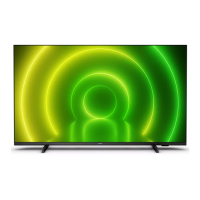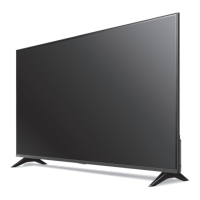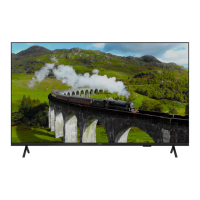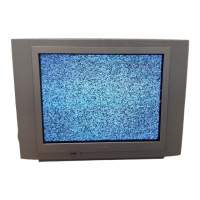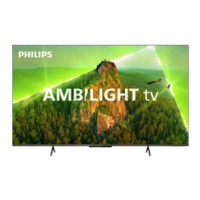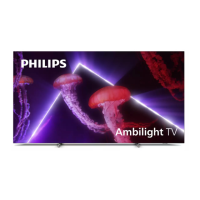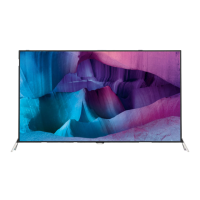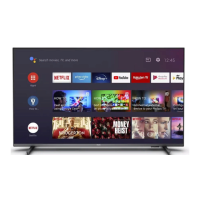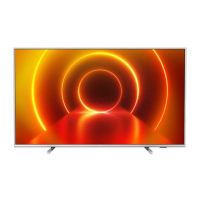Do you have a question about the Philips 7400 Series and is the answer not in the manual?
Overview of the Google TV Home screen's purpose and content discovery features.
Explains the Dashboard's features and how to access TV settings for adjustments.
Details the differences between Basic and Full operating modes for the TV.
Step-by-step guide to accessing the Home screen and launching content or apps.
Essential safety precautions to be read before operating the TV.
Instructions for safely installing the TV stand or mounting it on a wall.
Guidance on optimal TV placement for viewing distance and light conditions.
Proper procedures for connecting, securing, and unplugging the TV power cable.
How to correctly connect the antenna cable to the TV's antenna socket.
Explains the functions of the top and middle buttons on the TV remote control.
How to use voice commands for searching and the necessary remote pairing process.
Information about the TV's infrared sensor for remote control reception.
Instructions for replacing remote control batteries and maintaining its cleanliness.
Guide to installing channels during the initial TV setup process.
Steps for installing channels using an antenna connection.
How to manually perform a channel update to find new or changed channels.
How to check and improve the signal quality of digital TV channels.
How to enable or disable the Logical Channel Number feature for channel ordering.
Options for setting the type of channel scan and how channels are stored.
Procedure to skip channels that the user does not wish to watch.
How to change the position of channels within the channel list.
Guide to manually reordering channels in the TV's channel list.
Steps to edit existing channels, such as renaming or selecting them.
How to remove unwanted channels from the TV's channel list.
Method to re-sort channels by genre when LCN is turned off.
Instructions to remove all currently tuned channels from the TV.
General information on TV channels and how to switch between them.
Details on accessing, viewing, and sorting channel lists.
How to create and manage lists of favorite channels for quick access.
Setting up channel blocking and program restrictions for age-appropriate viewing.
Information on interactive TV services like HbbTV and iTV.
Guide to connecting external devices via antenna, HDMI, and USB ports.
How to connect a Home Theatre System using the HDMI ARC feature for audio.
Information on connecting video playback devices to the TV.
Explains the use of optical output for high-quality audio connections.
How to connect and use USB flash drives for media playback.
Prerequisites for connecting wireless Bluetooth® devices like speakers or headphones.
Step-by-step guide to pairing Bluetooth® devices with the TV.
How to choose which paired Bluetooth® device to use for audio output.
Instructions for renaming a paired Bluetooth® device for easier identification.
How to unpair or remove a connected Bluetooth® device from the TV.
Setting up the TV's connection to a home network via Wi-Fi or Ethernet.
Guidance on signing in and managing your Google Account for full TV functionality.
Information about installed apps, the Google Play Store, and app installation.
How to rent/buy movies, play music, and access games via Google Play.
Instructions on how to launch, close, and manage running applications on the TV.
Tips for optimizing app performance, clearing cache, and uninstalling unused apps.
How to select and switch between different input sources and connected devices.
Accessing core TV settings like Picture, Sound, Screen, Source, and Parental Controls.
How to select and adjust picture modes for optimal visual quality.
Detailed adjustments for backlight, contrast, color, sharpness, and advanced picture options.
Options to adjust the screen aspect ratio to fit content or fill the screen.
Configuring sound modes, volume, and advanced audio processing features.
System settings including accessibility, captions, and software updates.
How to check the current software version and release notes of the TV.
Displaying TV status information like IP address, MAC address, and serial number.
Accessing information on open source licenses and other legal terms.
Viewing detailed information about the TV's system components and OS.
Settings for configuring the TV's date, time, and time zone.
How to change the display language for menus and messages.
Settings and configuration for connected USB keyboards.
Checking the internal storage space used by apps, videos, and other data.
Configuring the screen saver or ambient mode for displaying photos or information.
Managing power behavior, energy saving settings, and timers for power on/off.
Setting notification preferences for media casting to the TV.
Enabling or disabling system sounds for various TV operations.
Accessing advanced settings for audio, subtitles, and teletext options.
Configuring the automatic power-off feature when no signal is detected.
Setting the channel that the TV defaults to upon startup.
Configuring options related to the HbbTV interactive television service.
Managing Over-the-air software update settings for the TV.
Checking detailed system information, including signal levels and service IDs.
Viewing the open source licenses applicable to the TV's software.
How to access and play media files from a connected USB flash drive.
Steps to play video files and available playback options.
How to view photos, sort them, and use photo frame features.
How to play audio files and manage music playback options.
How to view text files and adjust text display settings.
Requirements and availability of TV guide information for current and scheduled programs.
How the TV collects and displays TV guide information received from broadcasters.
How to cast content from smartphones and tablets to the TV using Chromecast.
Details on the TV's power requirements and operating ambient temperature.
Information about the Android OS version installed on the TV.
Technical details regarding TV tuner bands, reception standards, and video/audio playback formats.
Information on available screen sizes and the TV's native resolution.
Supported video and computer resolutions and their corresponding refresh rates.
List of available ports and connection types on the TV for external devices.
Specifications for the TV's audio output power and supported sound technologies.
Supported multimedia connections, file systems, and playback formats for various media types.
Benefits and procedure for registering the TV for extended support and product information.
Solutions for common TV issues such as power, remote control, and picture problems.
How to access Philips' online support portal for troubleshooting and manual downloads.
Information on contacting customer care for TV support and repair services.
Crucial safety instructions regarding electric shock, fire hazards, and preventing injury.
Guidelines for cleaning and maintaining the TV screen to prevent damage.
Trademark information and branding for the Google TV software experience.
Trademark and licensing information for the HDMI interface.
Patent information related to HEVC (High Efficiency Video Coding) technology.
Trademark and licensing details for Dolby's advanced audio and video technologies.
Trademark information pertaining to the Wi-Fi Alliance and its certifications.
Trademark information for Kensington security products, if applicable to the TV.
A statement acknowledging other registered and unregistered trademarks owned by their respective owners.
Overview of the Google TV Home screen's purpose and content discovery features.
Explains the Dashboard's features and how to access TV settings for adjustments.
Details the differences between Basic and Full operating modes for the TV.
Step-by-step guide to accessing the Home screen and launching content or apps.
Essential safety precautions to be read before operating the TV.
Instructions for safely installing the TV stand or mounting it on a wall.
Guidance on optimal TV placement for viewing distance and light conditions.
Proper procedures for connecting, securing, and unplugging the TV power cable.
How to correctly connect the antenna cable to the TV's antenna socket.
Explains the functions of the top and middle buttons on the TV remote control.
How to use voice commands for searching and the necessary remote pairing process.
Information about the TV's infrared sensor for remote control reception.
Instructions for replacing remote control batteries and maintaining its cleanliness.
Guide to installing channels during the initial TV setup process.
Steps for installing channels using an antenna connection.
How to manually perform a channel update to find new or changed channels.
How to check and improve the signal quality of digital TV channels.
How to enable or disable the Logical Channel Number feature for channel ordering.
Options for setting the type of channel scan and how channels are stored.
Procedure to skip channels that the user does not wish to watch.
How to change the position of channels within the channel list.
Guide to manually reordering channels in the TV's channel list.
Steps to edit existing channels, such as renaming or selecting them.
How to remove unwanted channels from the TV's channel list.
Method to re-sort channels by genre when LCN is turned off.
Instructions to remove all currently tuned channels from the TV.
General information on TV channels and how to switch between them.
Details on accessing, viewing, and sorting channel lists.
How to create and manage lists of favorite channels for quick access.
Setting up channel blocking and program restrictions for age-appropriate viewing.
Information on interactive TV services like HbbTV and iTV.
Guide to connecting external devices via antenna, HDMI, and USB ports.
How to connect a Home Theatre System using the HDMI ARC feature for audio.
Information on connecting video playback devices to the TV.
Explains the use of optical output for high-quality audio connections.
How to connect and use USB flash drives for media playback.
Prerequisites for connecting wireless Bluetooth® devices like speakers or headphones.
Step-by-step guide to pairing Bluetooth® devices with the TV.
How to choose which paired Bluetooth® device to use for audio output.
Instructions for renaming a paired Bluetooth® device for easier identification.
How to unpair or remove a connected Bluetooth® device from the TV.
Setting up the TV's connection to a home network via Wi-Fi or Ethernet.
Guidance on signing in and managing your Google Account for full TV functionality.
Information about installed apps, the Google Play Store, and app installation.
How to rent/buy movies, play music, and access games via Google Play.
Instructions on how to launch, close, and manage running applications on the TV.
Tips for optimizing app performance, clearing cache, and uninstalling unused apps.
How to select and switch between different input sources and connected devices.
Accessing core TV settings like Picture, Sound, Screen, Source, and Parental Controls.
How to select and adjust picture modes for optimal visual quality.
Detailed adjustments for backlight, contrast, color, sharpness, and advanced picture options.
Options to adjust the screen aspect ratio to fit content or fill the screen.
Configuring sound modes, volume, and advanced audio processing features.
System settings including accessibility, captions, and software updates.
How to check the current software version and release notes of the TV.
Displaying TV status information like IP address, MAC address, and serial number.
Accessing information on open source licenses and other legal terms.
Viewing detailed information about the TV's system components and OS.
Settings for configuring the TV's date, time, and time zone.
How to change the display language for menus and messages.
Settings and configuration for connected USB keyboards.
Checking the internal storage space used by apps, videos, and other data.
Configuring the screen saver or ambient mode for displaying photos or information.
Managing power behavior, energy saving settings, and timers for power on/off.
Setting notification preferences for media casting to the TV.
Enabling or disabling system sounds for various TV operations.
Accessing advanced settings for audio, subtitles, and teletext options.
Configuring the automatic power-off feature when no signal is detected.
Setting the channel that the TV defaults to upon startup.
Configuring options related to the HbbTV interactive television service.
Managing Over-the-air software update settings for the TV.
Checking detailed system information, including signal levels and service IDs.
Viewing the open source licenses applicable to the TV's software.
How to access and play media files from a connected USB flash drive.
Steps to play video files and available playback options.
How to view photos, sort them, and use photo frame features.
How to play audio files and manage music playback options.
How to view text files and adjust text display settings.
Requirements and availability of TV guide information for current and scheduled programs.
How the TV collects and displays TV guide information received from broadcasters.
How to cast content from smartphones and tablets to the TV using Chromecast.
Details on the TV's power requirements and operating ambient temperature.
Information about the Android OS version installed on the TV.
Technical details regarding TV tuner bands, reception standards, and video/audio playback formats.
Information on available screen sizes and the TV's native resolution.
Supported video and computer resolutions and their corresponding refresh rates.
List of available ports and connection types on the TV for external devices.
Specifications for the TV's audio output power and supported sound technologies.
Supported multimedia connections, file systems, and playback formats for various media types.
Benefits and procedure for registering the TV for extended support and product information.
Solutions for common TV issues such as power, remote control, and picture problems.
How to access Philips' online support portal for troubleshooting and manual downloads.
Information on contacting customer care for TV support and repair services.
Crucial safety instructions regarding electric shock, fire hazards, and preventing injury.
Guidelines for cleaning and maintaining the TV screen to prevent damage.
Trademark information and branding for the Google TV software experience.
Trademark and licensing information for the HDMI interface.
Patent information related to HEVC (High Efficiency Video Coding) technology.
Trademark and licensing details for Dolby's advanced audio and video technologies.
Trademark information pertaining to the Wi-Fi Alliance and its certifications.
Trademark information for Kensington security products, if applicable to the TV.
A statement acknowledging other registered and unregistered trademarks owned by their respective owners.
| Display Type | LED |
|---|---|
| Smart TV | Yes |
| Operating System | Android TV |
| HDMI Ports | 4 |
| USB Ports | 2 |
| Refresh Rate | 60 Hz |
| Resolution | 4K UHD (3840 x 2160) |
| Screen Size | 43, 50, 55, 65, 70 inches |
| Processor | Quad Core |
| Connectivity | Wi-Fi, Ethernet, Bluetooth |
| Voice Control | Google Assistant |
| Ambilight | Yes |
